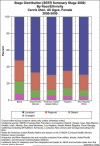Gynecologic cancer disparities: a report from the Health Disparities Taskforce of the Society of Gynecologic Oncology
- PMID: 24406291
- PMCID: PMC4079541
- DOI: 10.1016/j.ygyno.2013.12.039
Gynecologic cancer disparities: a report from the Health Disparities Taskforce of the Society of Gynecologic Oncology
Abstract
Objectives: To review the extent of health disparities in gynecologic cancer care and outcomes and to propose recommendations to help counteract the disparities.
Methods: We searched the electronic databases PubMed and the Cochrane Library. We included studies demonstrating quantifiable differences by race and ethnicity in the incidence, treatment, and survival of gynecologic cancers in the United States (US). Most studies relied on retrospective data. We focused on differences between Black and White women, because of the limited number of studies on non-Black women.
Results: White women have a higher incidence of ovarian cancer compared to Black women. However, the all-cause ovarian cancer mortality in Black women is 1.3 times higher than that of White women. Endometrial and cervical cancer mortality in Black women is twice that of White women. The etiology of these disparities is multifaceted. However, much of the evidence suggests that equal care leads to equal outcomes for Black women diagnosed with gynecologic cancers. Underlying molecular factors may play an additional role in aggressive tumor biology and endometrial cancer disparities.
Conclusion: Gynecologic cancer disparities exist between Black and White women. The literature is limited by the lack of large prospective trials and adequate numbers of non-Black racial and ethnic groups. We conclude with recommendations for continued research and a multifaceted approach to eliminate gynecologic cancer disparities.
Keywords: Cervical; Disparities; Endometrial and ovarian cancers; Ethnic; Gynecologic cancer; Racial.
Copyright © 2014 Elsevier Inc. All rights reserved.
Figures
References
-
- National Cancer Institute . Cancer Health Disparities [Internet] National Institute of Health; Bethesda (MD): 1999. [cited 2012 May 30]. Available from: http://www.cancer.gov/cancertopics/factsheet/disparities/cancer-health-d....
-
- Smedley BD, Stith AY, Nelson AR, editors. Unequal Treatment: Confronting Racial and Ethnic Disparities in Health Care. Vol. 20. National Academies Press; Washington, DC: 2003. - PubMed
-
- Cruz-Flores S, Rabinstein A, Biller J, Elkind MS, Griffith P, Gorelick PB, et al. Racial-ethnic disparities in stroke care: the American experience: a statement for healthcare professionals from the American Heart Association/American Stroke Association. Stroke. 2011 Jul;42(7):2091–116. - PubMed
-
- Lefebvre K, Metraux S. Disparity in level of amputation among minorities: implications for improved preventative care. J Natl Med Assoc. 2009 Jul;101(7):649–55. - PubMed
-
- Gunderman RB. Addressing racial and ethnic disparities in health care. Radiology. 2007 Jul;244(1):28–30. - PubMed
Publication types
MeSH terms
Grants and funding
LinkOut - more resources
Full Text Sources
Other Literature Sources
Medical



